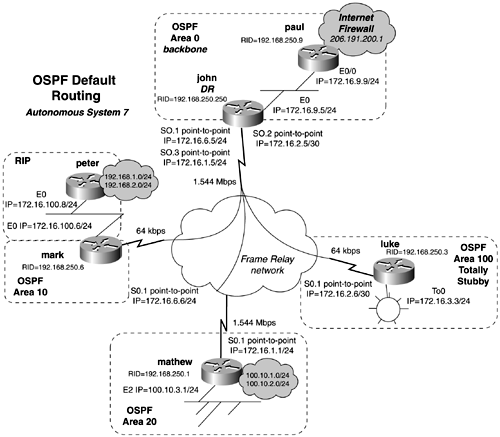Part V: Transporting Non-Routable Protocols
| < Free Open Study > |
OSPF Default RoutingToday, most, and potentially all, networks connect to the Internet. Some routers have registered address space, while others have Internet routers, or firewalls. Being able to generate and propagate a default route is important. Recall from earlier chapters that default routing is a three-step task:
Figure 12-11 adds another connection, 206.191.200.1, to the network that is the gateway to the Internet. To flag the network 206.191.200.0 as a default network, either of the two global configuration commands will work: Figure 12-11. OSPF Default Routing ip default-network 206.191.200.0 Or point it directly at an address: ip route 0.0.0.0 0.0.0.0 206.191.200.1 To propagate the default network, use the default-information originate always command. The always keyword always propagates a default route if the router flags the default network with the default-network command. Example 12-27 lists the configuration of paul and shows how the default route is configured. Example 12-27 Default Route Configuration on paulrouter ospf 7 router-id 192.168.250.9 redistribute connected subnets tag 9 network 172.16.9.0 0.0.0.255 area 0 default-information originate always Example 12-28 lists how the route is propagated into the NSSA area on the router mathew. Notice that the gateway of last resort now is set. Example 12-28 Route Table of mathewmathew# show ip route <<<text omitted>>> Gateway of last resort is 172.16.1.5 to network 0.0.0.0 100.0.0.0/24 is subnetted, 3 subnets C 100.10.2.0 is directly connected, Loopback21 C 100.10.3.0 is directly connected, Ethernet2 C 100.10.1.0 is directly connected, Loopback20 172.16.0.0/24 is subnetted, 8 subnets C 172.16.250.0 is directly connected, Loopback0 O IA 172.16.9.0 [110/74] via 172.16.1.5, 1d23h, Serial0.1 O 172.16.10.0 is a summary, 2d00h, Null0 O IA 172.16.6.0 [110/128] via 172.16.1.5, 1d23h, Serial0.1 C 172.16.1.0 is directly connected, Serial0.1 O 172.16.2.0 is a summary, 2d00h, Null0 O IA 172.16.3.0 [110/134] via 172.16.1.5, 1d23h, Serial0.1 O E2 172.16.100.0 [110/10] via 172.16.1.5, 02:54:58, Serial0.1 O E2 206.191.200.0/24 [110/20] via 172.16.1.5, 00:09:56, Serial0.1 12.0.0.0/16 is subnetted, 1 subnets O E2 12.16.0.0 [110/10] via 172.16.1.5, 1d23h, Serial0.1 O*E2 0.0.0.0/0 [110/1] via 172.16.1.5, 01:04:36, Serial0.1 O E2 192.168.0.0/16 [110/10] via 172.16.1.5, 01:36:57, Serial0.1 mathew# |
| < Free Open Study > |
EAN: 2147483647
Pages: 283
